
Which of the following cannot be used to make a magnet?
A) Cobalt
B) Iron
C) Ebonite
D) Steel
Answer
553.8k+ views
Hint: Magnets can only be made from ferromagnetic materials, materials that have permanent dipole moment present and arrange themselves when introduced to opposite poles. These ferromagnetic materials form magnetization when an external magnetic field or current is introduced.
Complete solution:
Let us check the options given, the minerals cobalt, and iron and steel are metals whereas ebonite is a black coloured substance with high concentration of rubber. Now rubber is an electrical insulator and an insulator can never have magnetic properties as there is no electron flow in the object whereas materials like cobalt, steel and iron are metals that have magnetic dipoles and electron flows through them forming magnetic domain which attracts dipole of opposite polarity and align themselves together to form a unidirectional magnetic field.
Let us check the following diagram to see how a ferromagnetic material works:

The dipoles before magnetization are moving or staying in different direction but when a magnetic field is applied the poles are align from positive to negative, the end of the arrow is positive and the top of the arrow is negative Therefore, the odd one out or the material that can't be formed into magnet is Ebonite.
Note: Unidirectional magnetism is formed by ferromagnetic material, unidirectional meaning that the path of the magnetic lines are originating from south to north or from positive to negative such properties can only be obtained when electrons in an object can flow freely.
Complete solution:
Let us check the options given, the minerals cobalt, and iron and steel are metals whereas ebonite is a black coloured substance with high concentration of rubber. Now rubber is an electrical insulator and an insulator can never have magnetic properties as there is no electron flow in the object whereas materials like cobalt, steel and iron are metals that have magnetic dipoles and electron flows through them forming magnetic domain which attracts dipole of opposite polarity and align themselves together to form a unidirectional magnetic field.
Let us check the following diagram to see how a ferromagnetic material works:

The dipoles before magnetization are moving or staying in different direction but when a magnetic field is applied the poles are align from positive to negative, the end of the arrow is positive and the top of the arrow is negative Therefore, the odd one out or the material that can't be formed into magnet is Ebonite.
Note: Unidirectional magnetism is formed by ferromagnetic material, unidirectional meaning that the path of the magnetic lines are originating from south to north or from positive to negative such properties can only be obtained when electrons in an object can flow freely.
Recently Updated Pages
Master Class 12 Business Studies: Engaging Questions & Answers for Success

Master Class 12 Social Science: Engaging Questions & Answers for Success

Master Class 12 English: Engaging Questions & Answers for Success

Master Class 12 Chemistry: Engaging Questions & Answers for Success

Class 12 Question and Answer - Your Ultimate Solutions Guide

Master Class 12 Economics: Engaging Questions & Answers for Success

Trending doubts
What are the major means of transport Explain each class 12 social science CBSE

Which are the Top 10 Largest Countries of the World?

Draw a labelled sketch of the human eye class 12 physics CBSE

How much time does it take to bleed after eating p class 12 biology CBSE

Explain sex determination in humans with line diag class 12 biology CBSE

Differentiate between homogeneous and heterogeneous class 12 chemistry CBSE




